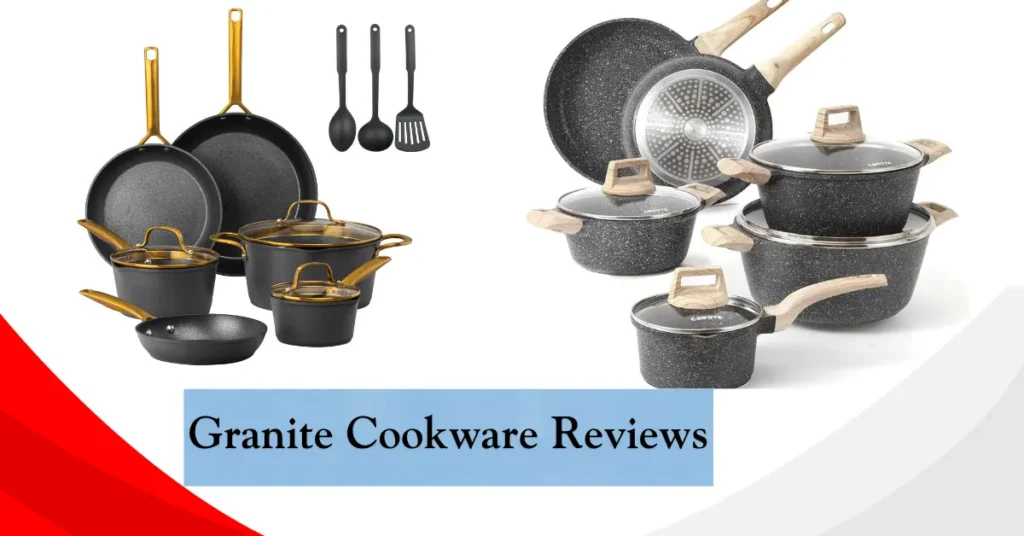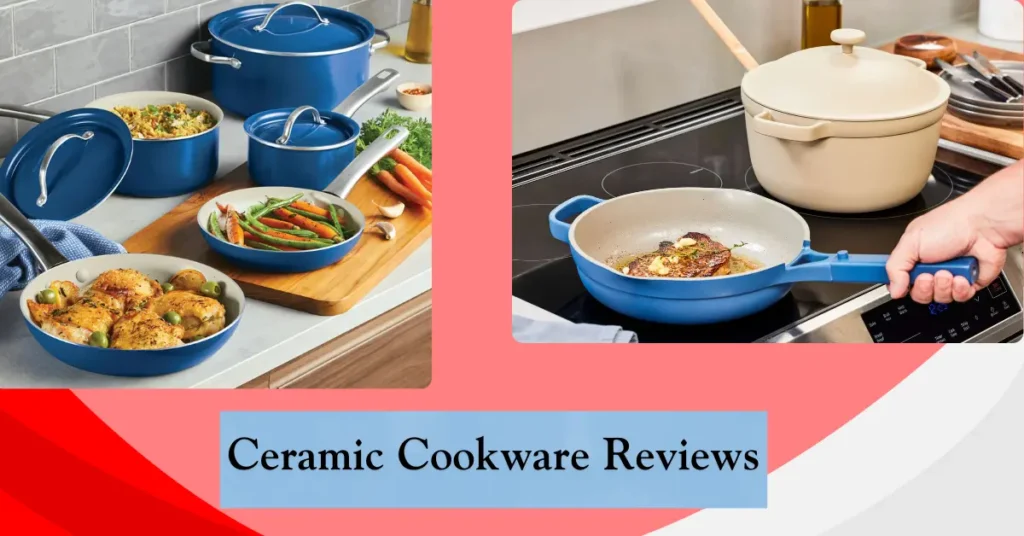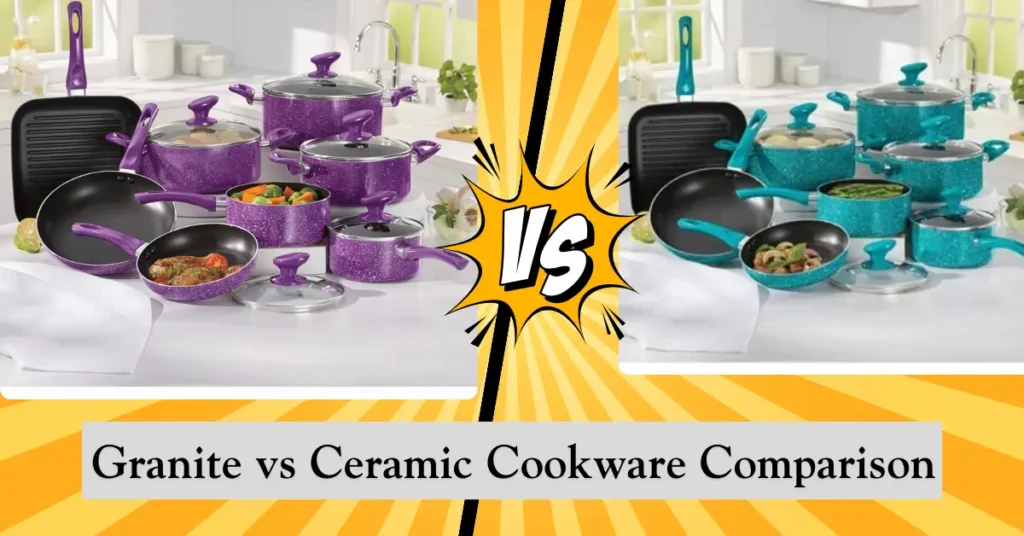Choosing between granite vs ceramic cookware can be a bit overwhelming. Both are popular options, but they each have their own strengths. After using both, I’ve noticed some key differences that can help make your decision easier. Many people wonder which one is better for cooking or even which is safer.
It’s important to look at things like heat distribution, durability, and safety. In this review, I’ll break down the pros and cons of each, based on my experience. By the end, you’ll have a better idea of which one fits your cooking style. Let’s dive in!

Granite Cookware Reviews
I’ve been using granite cookware for over two years, and it’s quickly become a favorite in my kitchen. The combination of style, performance, and durability makes it stand out. Here’s a closer look at why it might be just what you need.
What I Like
I’ve been using granite cookware for a while now, and there’s a lot I love about it. From the ease of cooking to the effortless cleanup, it’s truly been a game-changer for me.
- Super Non-Stick Surface: The non-stick surface is one of my absolute favorites. Food slides off easily, even without added oils or butter. I can cook without worrying about sticking, which is such a relief.
- Easy Cleanup: Cleanup is incredibly simple. After I’m done cooking, all it takes is a quick wipe or rinse. No need for scrubbing or soaking – it saves me so much time.
- Healthy Cooking: Cooking with less oil means my meals are healthier. I love that I can still enjoy delicious, flavorful food without extra fats.
- Even Heat Distribution: The heat is distributed evenly across the pan, which means no more burnt spots or undercooked areas. Every meal cooks perfectly.
- Durable: After over two years of regular use, my granite cookware still looks and performs like new. It’s built to last and keeps delivering great results.
What Could Be Better
While I love using granite cookware, there are a few things that could be improved. I still think it’s a fantastic option, but there’s always room for a little refinement.
- Weight: Granite cookware can be a bit heavy. At first, it took some getting used to, especially when I needed to lift a larger pan. It’s not a deal-breaker, but a lighter version would make handling easier.
- Induction Compatibility: Not all granite cookware works on induction stovetops. For those of us with induction ranges, this can be a bit limiting. It’s important to double-check before purchasing.
- Handles Can Get Hot: Most of the time, the handles stay cool, but occasionally, they can get a little warm when cooking at high heat. A more consistent cool-touch handle would be great.
- Price Range: Granite cookware tends to be a bit more expensive than other non-stick options. While it’s definitely worth the price for its quality and durability, it might feel like a higher upfront cost for some.
My Personal Experience
I’ve been using granite cookware for over two years now, and I can confidently say it’s one of the best kitchen investments I’ve made. Whether I’m cooking a quick breakfast or preparing a big family meal, it always delivers.
Is Granite Cookware Safe for Health?
Design
The design of granite cookware is both practical and stylish. I love how sleek and modern it looks in my kitchen. The non-stick coating gives it a beautiful, shiny finish that adds to the overall appeal. But the design is not just for looks – the ergonomic handles are comfortable to hold, making cooking a breeze. I’ve never had an issue with the handles getting too hot, and they’re designed in such a way that they’re easy to grip from any angle.
Performance
The performance of granite cookware has been outstanding. It heats up quickly and evenly, ensuring that my food is cooked to perfection every time. Whether I’m searing steaks or sautéing vegetables, the heat distribution is consistently even. I don’t have to worry about hot spots, which makes cooking so much easier. The non-stick surface also means I don’t need to use much oil, which leads to healthier meals.
Build Quality
The build quality of granite cookware is impressive. After using it for more than two years, I can honestly say it’s built to last. The material is durable, resistant to scratches, and shows no signs of warping. The cookware still looks new, even with frequent use. I also appreciate how well it holds up under high heat. Whether I’m baking or frying, I know the cookware can handle it without any issues.

Ceramic Cookware Reviews
I’ve been using ceramic cookware for a while now. It’s become a staple in my kitchen. After trying several brands, I have a solid understanding of what ceramic cookware can do. In this review, I’ll share what I like, what could be better, and my personal experience.
What I Like
There is a lot to love about ceramic cookware. It’s a great choice if you want to upgrade your kitchen tools. Here’s what stands out for me:
- Non-Toxic Coating: Ceramic cookware is free from harmful chemicals like PFOA, PTFE, and lead. Knowing it’s safe makes me feel good, especially when I’m cooking for my family.
- Non-Stick Surface: The non-stick properties are amazing. I can cook eggs or pancakes without worrying they’ll stick. Cleanup is also easy, which is great after a busy cooking day.
- Even Heat Distribution: Ceramic cookware heats up quickly and evenly. This means no hot spots. My food cooks evenly, even when I’m multitasking in the kitchen.
- Versatile and Stylish: Ceramic cookware comes in bright colors that look great in my kitchen. It works on most stovetops and in the oven, giving me more ways to cook.
- Easy to Clean: Ceramic is low-maintenance. Food residue doesn’t stick, so a quick wipe or wash is usually all it needs. This is great for someone like me who values convenience.
What Could Be Better
While I love my ceramic cookware, there are a few things that could be improved. Here’s what I’ve noticed over time:
- Durability Over Time: The non-stick surface can wear off with use. To keep it in good shape, I avoid metal utensils and harsh cleaning tools. It would be nice if the coating lasted longer.
- Weight: Some ceramic cookware is a bit heavier than other types. It’s not a huge problem, but it might take time to get used to, especially for those who like lightweight pans.
- Induction Compatibility: Not all ceramic cookware works on induction cooktops. If you have induction, make sure the cookware is compatible before buying it.
- Price: Ceramic cookware can be more expensive than regular non-stick or stainless steel. But I think it’s worth the investment for the health benefits and ease of use. It may not fit every budget, though.
My Personal Experience
I’ve been using ceramic cookware for about a year now. It has made cooking easier and more fun. Here’s what I’ve noticed.
Design
The design of ceramic cookware is one of my favorite things. It looks sleek and shiny. The finish is smooth and makes my kitchen feel more stylish. The handles are also great. They stay cool, so I can move the pans easily from the stove to the counter. It’s clear that a lot of thought went into the design, making it both practical and good-looking.
Performance
The performance is excellent. The even heat distribution is one of the best features. I can cook meat or sauces without worrying about hot spots. The non-stick surface works really well, especially with foods like eggs or delicate fish. I’ve noticed that cooking time is more predictable. It makes meal prep faster and more enjoyable.
Build Quality
The build quality is solid. The pans feel sturdy. They have a thick base that helps with heat distribution. Cleaning is easy too. After making something like lasagna, it’s simple to clean with just a little soap and water. However, I have to be careful. The non-stick coating can wear out over time if I’m not careful.

Granite vs Ceramic Cookware Comparison
I’ve been using both granite and ceramic cookware for some time now, and it’s safe to say that they both have their strengths and weaknesses. While they may look similar, their performance and durability can differ significantly.
Let’s dive into a comparison of these two types of cookware to see which one might be the best fit for your kitchen.
Durability: Granite vs Ceramic Cookware
Granite cookware tends to have a tougher exterior, offering more resistance to scratches and dents, whereas ceramic cookware is more fragile, especially if dropped.
| Feature | Granite Cookware | Ceramic Cookware |
| Scratch Resistance | High | Moderate |
| Chip Resistance | Moderate | Low |
| Lifetime | Long-lasting | Can wear down over time |
Granite Cookware Rating: 9/10
Ceramic Cookware Rating: 7/10
Non-Stick Properties: Granite vs Ceramic Cookware
Both granite and ceramic cookware offer great non-stick properties. However, ceramic may lose its non-stickiness after frequent use, while granite typically maintains its non-stick surface for longer.
| Feature | Granite Cookware | Ceramic Cookware |
| Non-Stick Surface | Excellent | Very good, can degrade |
| Longevity of Non-Stick | Longer-lasting | Can fade over time |
Granite Cookware Rating: 9/10
Ceramic Cookware Rating: 8/10
Heat Distribution: Granite vs Ceramic Cookware
Granite cookware generally provides more even heat distribution due to its heavy base, while ceramic cookware may heat unevenly, especially on stovetops with fluctuating temperatures.
| Feature | Granite Cookware | Ceramic Cookware |
| Heat Distribution | Excellent | Good, but not as even |
| Cooking Performance | Consistent, no hot spots | Some hot spots possible |
Granite Cookware Rating: 9/10
Ceramic Cookware Rating: 7/10
Cleaning and Maintenance: Granite vs Ceramic Cookware
Both types are easy to clean, but ceramic cookware may require more maintenance due to the tendency of its non-stick surface to wear down. Granite is slightly more durable in this aspect.
| Feature | Granite Cookware | Ceramic Cookware |
| Cleaning Ease | Easy, with gentle scrub | Easy, but may need more care |
| Maintenance | Low | Moderate to High |
Granite Cookware Rating: 8/10
Ceramic Cookware Rating: 7/10
Non-Toxic: Granite vs Ceramic Cookware
Both granite and ceramic cookware are typically marketed as non-toxic options, free of harmful chemicals like PFOA, PTFE, and lead. However, some low-end ceramic cookware may still contain questionable chemicals.
| Feature | Granite Cookware | Ceramic Cookware |
| Toxin-Free | Yes | Yes, but check for quality |
| Safety | Excellent | Good (depends on brand) |
Granite Cookware Rating: 9/10
Ceramic Cookware Rating: 8/10
Versatility: Granite vs Ceramic Cookware
Granite cookware is often more versatile, working on all stovetops and being oven-safe at higher temperatures. Ceramic cookware may not be suitable for high-heat cooking or induction stovetops.
| Feature | Granite Cookware | Ceramic Cookware |
| Stovetop Compatibility | All stovetops (except induction) | Gas, electric, some are oven safe |
| Oven-Safe Temperature | Higher (up to 500°F) | Typically lower (up to 350°F) |
Granite Cookware Rating: 9/10
Ceramic Cookware Rating: 7/10
Fragility: Granite vs Ceramic Cookware
Granite cookware is generally tougher and more resistant to breakage, while ceramic cookware is more fragile and prone to cracking if dropped.
| Feature | Granite Cookware | Ceramic Cookware |
| Fragility | Low | High |
| Durability | High | Moderate |
Granite Cookware Rating: 9/10
Ceramic Cookware Rating: 6/10
Heat Retention: Granite vs Ceramic Cookware
Granite cookware has superior heat retention, which is great for slow cooking and keeping food warm. Ceramic cookware heats up quickly but doesn’t retain heat as well.
| Feature | Granite Cookware | Ceramic Cookware |
| Heat Retention | Excellent | Moderate |
| Cooking Performance | Ideal for slow cooking | Quick cooking, but less even heat |
Granite Cookware Rating: 9/10
Ceramic Cookware Rating: 7/10
Construction: Granite vs Ceramic Cookware
Granite cookware typically has a more solid construction, offering durability with a heavy base and often reinforced with layers. Ceramic cookware is lighter but may lack the sturdiness of granite.
| Feature | Granite Cookware | Ceramic Cookware |
| Build Quality | Sturdy, heavy | Lighter, sometimes flimsy |
| Durability | High | Moderate |
Granite Cookware Rating: 9/10
Ceramic Cookware Rating: 7/10
Safety: Granite vs Ceramic Cookware
Granite cookware is safe as long as it is used within the recommended temperature range. Ceramic cookware is also safe but can crack under extreme temperatures.
| Feature | Granite Cookware | Ceramic Cookware |
| Safe Use Temperature | High | Moderate to High |
| Durability in Heat | High | Low |
Granite Cookware Rating: 9/10
Ceramic Cookware Rating: 7/10
Stick Resistance: Granite vs Ceramic Cookware
Granite cookware typically has a longer-lasting non-stick surface compared to ceramic cookware, which can degrade more quickly over time.
| Feature | Granite Cookware | Ceramic Cookware |
| Stick Resistance | Excellent | Good, but can fade |
| Longevity | High | Moderate |
Granite Cookware Rating: 9/10
Ceramic Cookware Rating: 7/10
Cooking Temperature: Granite vs Ceramic Cookware
Granite cookware can handle higher temperatures, making it better suited for high-heat cooking. Ceramic cookware is usually better suited for lower to moderate temperatures.
| Feature | Granite Cookware | Ceramic Cookware |
| Max Temperature | 500°F | 350°F |
| High-Heat Cooking | Ideal for searing & browning | Best for low/medium heat |
Granite Cookware Rating: 9/10
Ceramic Cookware Rating: 6/10
Price: Granite vs Ceramic Cookware
Granite cookware is generally more expensive due to its durability and longer-lasting non-stick surface. Ceramic cookware is often cheaper but may need to be replaced sooner.
| Feature | Granite Cookware | Ceramic Cookware |
| Price Range | Higher | Lower |
| Long-Term Cost | Worth the investment | May need replacement |
Granite Cookware Rating: 8/10
Ceramic Cookware Rating: 7/10
Final Thoughts
Granite cookware stands out in terms of durability, heat distribution, and non-stick performance, making it ideal for those who want a long-lasting investment. Ceramic cookware, while more affordable, may not hold up as well in the long term but is still a good choice for those on a budget and looking for a toxin-free option. Both have their unique qualities, so it ultimately depends on your needs, cooking style, and budget.
FAQs: Granite vs Ceramic Cookware
1. Which is better: granite or ceramic cookware?
Both granite and ceramic cookware have their benefits. Granite is durable and often has better heat retention, while ceramic cookware is typically more non-toxic. It depends on your needs!
2. Is granite cookware safe to use?
Yes, granite cookware is generally safe. Most brands use a non-toxic coating, but it’s important to check for any chemicals in the finish. Be sure to use it properly to avoid damage.
3. What is the healthiest cookware to use?
Ceramic cookware is considered one of the healthiest options because it doesn’t contain harmful chemicals like PTFE or PFOA. It’s a good choice for those looking to avoid toxins.
4. How does granite cookware compare to ceramic in heat distribution?
Granite cookware typically provides better heat retention. However, ceramic cookware heats evenly, making it great for cooking delicate dishes.
5. Can I use granite or ceramic cookware on high heat?
Granite cookware handles high heat better than ceramic, which can crack if exposed to too much heat. Always check the manufacturer’s guidelines for the best usage.
With over 8 years of experience in the culinary and kitchen tools industry, I specializes in finding/reviewing high-performance cookware and innovative kitchen technology. My expert insights help both chefs and home cooks find efficient, user-friendly tools that enhance their cooking experience and elevate kitchen efficiency. More about Raimul…

